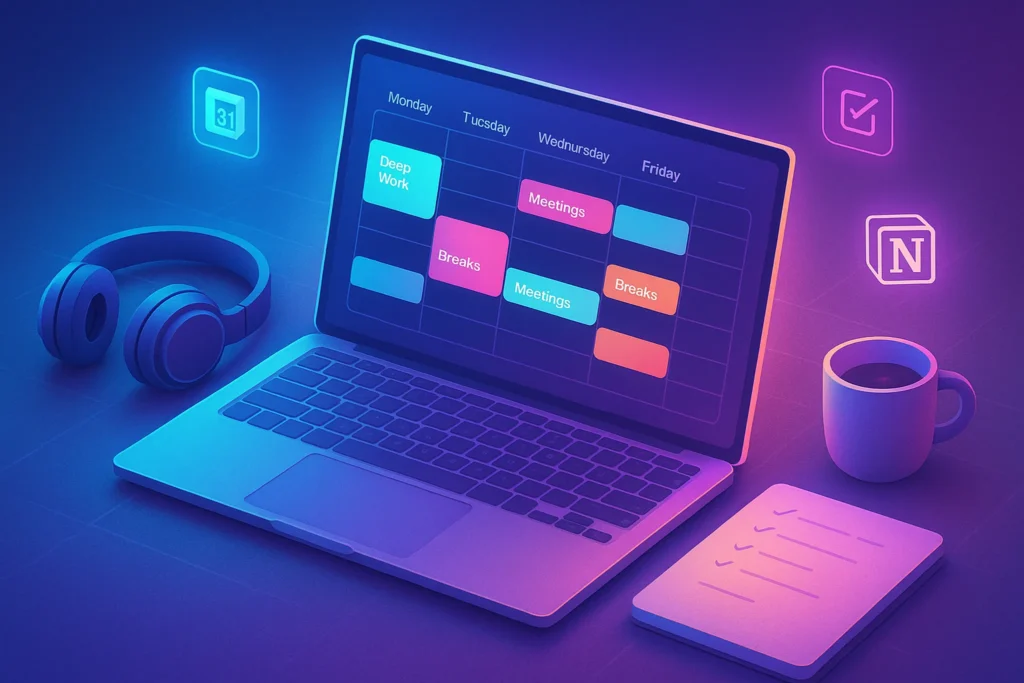-This post may contain affiliate links. If you click on one and make a purchase, I may earn a small commission at no extra cost to you.-
🧠 Introduction
Do you ever feel like you’re busy non-stop—yet never get your most important work done? Your time gets eaten by distractions, shallow tasks, and reactive emails. Time blocking changes that.
By assigning specific time slots to activities, time blocking creates mental clarity and structure. It turns vague intentions into clear deadlines and reduces task-switching fatigue. In this guide, you’ll learn how to:
-
Understand what time blocking really is
-
Build your first weekly time-block schedule
-
Customize your blocks for creative flow and deep work
-
Track and refine your system over time
Let’s transform your to-do list into calm, focused intention.
1️⃣ What Is Time Blocking (And Who It’s For)
Time blocking divides your day into labeled blocks—like “Deep Work,” “Email,” “Break,” etc.—instead of leaving everything in an open to-do list.
✅ Benefits:
-
Better focus: Knowing exactly what to do reduces decision fatigue
-
Flow boosting: Uninterrupted time leads to deeper engagement
-
Alignment with priorities: Blocks reflect what truly matters
🎯 Ideal For:
-
Writers, developers, designers needing deep focus
-
Knowledge workers juggling meetings and tasks
-
Anyone feeling overwhelmed or reactive to busywork
Audit Your Week (The Hidden Time Drain Game)
Before you block time, you need to see where your time is actually going—because most of us wildly misjudge it.
Spend 3–5 days capturing your day in 30-minute increments:
-
What were you doing?
-
How focused were you?
-
Was it deep work, admin, reactive tasks, or rest?
Tools you can use:
-
Manual journal (paper or Notion)
-
Apps like RescueTime, Toggl Track, or Clockify
Look for:
-
Repeating distractions (Slack, email, meetings)
-
Energy dips (afternoons?)
-
Unstructured time gaps
This self-audit creates the raw material for intelligent time blocking.
You can’t fix what you don’t track.
2️⃣ Step-by-Step: Create Your First Time Block Plan
🧠 Step 1: Start With a Reality Check – Audit Your Time Honestly
Before you can take control of your schedule, you need to face a truth most people avoid: you don’t really know where your time goes.
We all assume we’re productive—but assumptions are dangerous. That’s why every effective time blocking strategy starts with an honest audit.
For three to five days, track your time in 30-minute chunks. This doesn’t need to be high-tech. A simple table in Notion, a note on your phone, or even pen and paper will do. Write down exactly what you’re doing, how focused you felt, and whether the task was deep, shallow, or reactive.
Don’t try to fix anything yet—just observe.
You’ll likely discover:
-
Whole hours lost to checking Slack or Discord
-
“Quick emails” ballooning into 90-minute rabbit holes
-
Shallow admin work leaking into your creative energy zones
This process isn’t about judgment. It’s about gaining visibility. Because once you know what your real week looks like, you can begin designing your ideal one.
Step A: Audit Your Week
Spend one week tracking how you really spend time. Include meetings, email, breaks, context switching, and official deep work.
🎯 Step B: Identify High-Impact Activities
List tasks that deliver measurable results—blog writing, coding, marketing planning, strategic thinking.
🕰 Step C: Map Your Energy Patterns
Track your energy for a few days: when do you feel sharpest? That’s prime real estate for creative time blocks.
🧩 Step D: Assign Blocks to Your Calendar
Using tools like Google Calendar, Notion’s calendar view, or Sunsama:
-
Use “Deep Work” blocks during peak energy times
-
Reserve “Shallow Work” for administrative or reactive tasks
-
Include buffer time and self-care breaks
🔁 Step E: Commit & Adjust
Follow your first week plan, track completion, and refine:
-
Are deep blocks being used for deep work?
-
Are email blocks dragging into deep time?
-
Adjust lengths, start times, and labels based on real data
Identify High-Impact Activities
Not all tasks are created equal.
Time blocking isn’t just about control—it’s about prioritization. Start by listing all your recurring and upcoming tasks. Then ask:
-
Which ones drive results? (e.g., sales, content, strategy)
-
Which are unavoidable admin?
-
Which could be batch-processed or eliminated?
Use the Eisenhower Matrix:
-
Important + Urgent → Block them early
-
Important + Not Urgent → Schedule now!
-
Not Important + Urgent → Delegate or batch
-
Not Important + Not Urgent → Eliminate
This step helps you filter for impact before assigning time.
Optimize Blocks for Flow and Energy
🎯 Step 2: Identify the Work That Actually Moves the Needle
Once you’ve gathered raw time data, it’s time to filter it through the lens of impact.
Not all work is equal. Some tasks move you closer to your goals. Others just keep you busy.
Time blocking isn’t about doing more—it’s about doing what matters, with intention.
Look through your list of tasks and ask:
-
Which ones generate momentum?
-
Which directly support your goals or KPIs?
-
Which tasks could you delegate, batch, or delete?
Let’s say you’re a content strategist. Writing pillar blog posts probably creates more impact than spending an hour organizing Google Drive folders. If you’re a designer, deep creative sessions matter more than attending back-to-back status calls.
Clarifying your high-impact activities allows you to protect them in your calendar. These are the tasks that get the first blocks. Everything else comes after.
When in doubt, ask: What would future me thank me for doing this week?
🎯 Deep Work Practices:
-
Turn phone to Do Not Disturb
-
Close unrelated browser tabs
-
Use music or white noise to signal focus mode
⏳ Pomodoro Variation:
-
50-minute block, 10-minute break
-
25/5 works too. Use whichever keeps your flow
🧘 Short Rest Blocks:
-
Even 3-minute micro-breaks home resets
-
Include water, eye relief, quick stretch, or mindful breathing
Map Your Energy (Find Your Deep Work Windows)
Energy isn’t flat. Most people assume 8 hours = 8 hours of potential work—but we know better.
Track your energy for a week in a simple table:
| Time Slot | Energy (1-5) | Notes |
|---|---|---|
| 9–11 AM | 4.5 | Great focus, deep work zone |
| 1–3 PM | 2 | Sleepy, good for admin |
| 4–6 PM | 3.5 | Creative but scattered |
Now ask:
-
When am I mentally sharpest? (Schedule Deep Work)
-
When am I physically or emotionally low? (Schedule breaks, email, light tasks)
Time blocking aligned with energy = sustainable performance.
Build Habit with Routines & Accountability
🔋 Step 3: Match Your Tasks to Your Natural Energy Rhythms
Your calendar might say you’re available from 9 to 5, but your brain knows better.
You’re not a machine. Your energy rises and falls across the day. The problem is, most people schedule tasks based on availability—not based on focus capacity. And that’s a recipe for frustration.
Instead, spend a few days noticing when you feel sharpest. Some people do their best work at 7AM. Others don’t hit their creative stride until late afternoon. Track your energy levels along with your task audit. Use a simple scale from 1 to 5 to log your energy and focus.
Once you know your peaks and dips, you can plan smarter:
-
Put your most demanding, strategic, or creative work in your “peak hours”
-
Reserve administrative or repetitive tasks for when energy dips
-
Build in breaks around transition points
This is how you align time blocking with your biology—not just your calendar.
Daily structure solidifies your blocks:
-
Start-of-day ritual: Review today’s blocks and intentions
-
Evening planning ritual: Reflect and migrate unfinished tasks
-
Weekly review: Analyze block effectiveness and energy matches
For guided rituals, check our Beginner’s Guide to Time Blocking… and for broader systems, see how this fits into your larger productivity system that actually works.
Build Your First Time Block Schedule
This is the heart of it all.
Using your energy map and task priorities, start by filling just 60% of your day:
-
2 blocks of Deep Work (60–90 mins)
-
1 block Admin (30–60 mins)
-
1–2 Short Breaks
-
1 Reflection/Wrap-Up block
Use Google Calendar, Notion, or Sunsama to block these with labels.
Pro tips:
-
Color-code: red for deep, gray for admin, blue for personal
-
Theme days: Monday = Strategy, Tuesday = Creation, Friday = Review
-
Include transitions: Don’t stack back-to-back blocks without breaks
Don’t aim for the “perfect week”—start with a realistic one and optimize later.
Commit, Test, Adjust
Now that your blocks are in place, the real test begins: execution.
Here’s how to commit:
-
Treat blocks like meetings—non-negotiable and visible
-
Use a start-of-day ritual: review blocks + set 3 intentions
-
Keep a block accuracy log: did you start + finish it as planned?
At week’s end, review:
-
Which blocks did you skip? Why?
-
Were you over-optimistic about your time or energy?
-
Did you allow distractions to hijack your focus?
Tools that help:
-
Daily journaling in Notion
-
Sunsama auto-tracking
-
Simple “Done vs Planned” tally system
With each iteration, your system becomes more you.
Time blocking isn’t rigid—it’s responsive structure.
🧱 Step 4: Build Your First Blocked Schedule—Don’t Aim for Perfection
You’ve gathered your audit, you know your priorities, and you’ve mapped your energy. Now it’s time to actually build your first week of time blocks.
Open your calendar and start small. You’re not creating the “perfect week.” You’re creating a realistic draft.
Block out time for just three things:
-
Deep Work (1–2 sessions per day, 60–90 mins)
-
Admin or Shallow Work (1 session daily)
-
Breaks and Transition Time (yes—schedule rest!)
Name your blocks clearly: “Write Draft 1 of blog post” is better than “Work.”
Color-code if you like. And be generous with buffers—schedule “catch-up” slots at the end of each day or week. Life is unpredictable. Time blocking isn’t about rigidity. It’s about having a plan you can flex.
You’ll likely feel clunky your first week. That’s normal. But even a half-working time-blocked week is usually more productive than a fully reactive one.
🔁 Step 5: Review, Adjust, and Repeat—This Is a Practice
One week of time blocking is a good start. But it’s the review and refinement loop that turns this method into a habit—and a superpower.
Set a recurring 30-minute block each Friday or Sunday to reflect:
-
Did you actually follow your plan?
-
Which blocks worked well? Which ones consistently broke?
-
Were you too optimistic about your time or focus?
Write your observations somewhere—your Notion dashboard, a journal, or a Google Doc. Then, update next week’s blocks with those insights.
The goal here is not a perfect calendar—it’s a progressively smarter one. Every weekly review makes your system more personalized, more aligned, and more powerful.
You’re not just scheduling your time. You’re sculpting a life that supports the work and outcomes you care about.
Troubleshooting Common Challenges
❌ Overfilling Your Schedule
Block only 60–80% of your day; leave room for reality
💬 Unplanned Interruptions
Protect deep blocks—silence notifications, use “In a Meeting” status
Reschedule disruptions instead of reacting
😓 Low-Motivation Days
Use fallback “micro-focus” blocks—just show up for 5 minutes
📈 Desk Drift (Time Drifts)
Set buffer alarms and reassess weekly
🧠 Expanded Insights & Bonus: Mastering Time Blocking Long-Term
🔄 How to Make Time Blocking Stick Long-Term
Most beginners drop time blocking within two weeks—not because it doesn’t work, but because they set unrealistic expectations. Here’s how to overcome that and turn it into a lasting productivity system.
1. Don’t Schedule Every Minute
Leave buffer zones between blocks. For example:
-
Deep Work: 9:00–10:30
-
Buffer: 10:30–10:45
-
Emails: 10:45–11:15
These buffers absorb overflows, rest, or unexpected changes without derailing your plan.
2. Create Default Weekly Templates
Instead of planning from scratch every week, design a template:
-
Mornings: Deep Work
-
Midday: Admin/Meetings
-
Afternoons: Creative or Social Tasks
-
Friday PM: Planning/Review
Update only what’s changed—this preserves decision energy.
3. Track Block Accuracy
After a few weeks, evaluate:
-
% of blocks fully completed
-
Blocks that frequently break (why?)
-
Do blocks reflect your actual life or your ideal week?
Use a Notion table or Sunsama’s history view to spot patterns. Use data, not guilt, to refine.
🧩 Bonus: 3 Time Blocking Variations for Different Personality Types
Time blocking isn’t one-size-fits-all. Depending on your work style, you can modify your approach:
🔹 The Time Chunker (Structured)
-
Works best with fixed tasks, recurring responsibilities
-
Blocks are consistent daily: “Emails at 9AM, Projects at 10AM…”
Ideal for: project managers, developers, admins
🔹 The Flow Seeker (Flexible)
-
Plans only 2–3 blocks per day
-
Chooses tasks based on energy and mood inside those blocks
-
Leaves larger creative zones open-ended
Ideal for: creatives, writers, solopreneurs
🔹 The Theme Day Planner
-
Assigns themes to days (e.g., Monday = Meetings, Wednesday = Content, Friday = Finance)
-
Blocks are arranged around the day’s core focus
Ideal for: founders, marketers, service-based professionals
Try each style for 2–3 weeks and see which fits your lifestyle—not your calendar fantasy.
🔍 Recap
For deeper planning systems and habit layering, check out our:
These will show you how time blocking integrates with larger goal frameworks.
🧠 Nerd Verdict
Time blocking isn’t about packing busyness—it’s about creating intentional architecture for your priorities. When done with energy-awareness, buffer space, and regular refinement, it transforms your day from reactive to proactive and gives back mental clarity and creative space.
❓ FAQ
Q: How long should my time blocks be?
-
60–90 mins for deep work; 25–30 mins for admin; 5–10 mins for breaks
Q: What if I miss a block?
-
Don’t reset—just reschedule to catch-up slot. Momentum matters more than perfection.
Q: Do I need paid tools?
-
No. Paper planners work. But digital tools like Google Calendar, Notion, or Sunsama add flexibility and tracking
Q: Can Pomodoro + Time Blocking coexist?
-
Absolutely—use Pomodoro inside larger time blocks to boost flow
💬 Would You Bite?
What’s your biggest challenge with sticking to a time-blocked schedule?
📌 Do you feel ready for AI-powered threats? Or are deepfakes, malware-as-code, and model attacks keeping you on edge?
Drop your answer in the comments. I respond to every question—and happy to share real calendar screenshots if that helps! Let’s build your time ownership system together.👇



